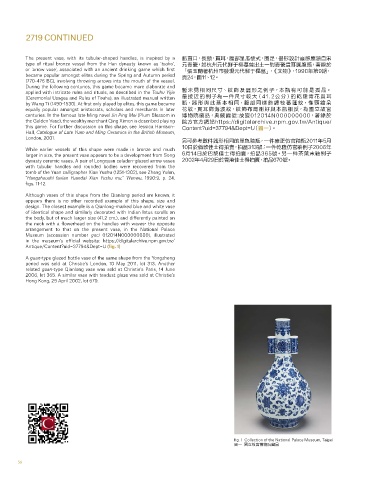Page 60 - Christie's Hong Kong Wang Zing Lou Collection May 30 2022
P. 60
2
1
7
CONT
INUED
9
2719 CONTINUED
The present vase, with its tubular-shaped handles, is inspired by a 瓶直口,長頸,貫耳,腹部呈瓜棱式,圈足,器形設計靈感應源自宋
type of ritual bronze vessel from the Han dynasty known as ‘touhu’, 元青瓷,如杭州元代鮮于樞墓曾出土一對青瓷貫耳圓腹瓶,著錄於
or ‘arrow vase’, associated with an ancient drinking game which first 「張玉蘭著杭州市發現元代鮮于樞墓」,《文物》,1990年第9期,
became popular amongst elites during the Spring and Autumn period 頁24,圖11、12。
(770-476 BC), involving throwing arrows into the mouth of the vessel.
During the following centuries, this game became more elaborate and
applied with intricate rules and rituals, as described in the Touhu Yijie 暫 未 見 相 同尺寸、紋 飾 及 器 形之例 子,本 瓶 有 可能 是 孤 品。
(Ceremonial Usages and Rules of Touhu), an illustrated manual written 最 接 近的例 子為一 件尺寸 較 大(41. 2公 分)的乾 隆 青花 貫 耳
by Wang Ti (1490-1530). At first only played by elites, this game became 瓶,器 形 與 此 基本 相 同,腹 部 同 樣 飾 纏枝 蕃 蓮 紋,惟頸 繪 朵
equally popular amongst aristocrats, scholars and merchants in later 花 紋,貫耳飾海波 紋,紋 飾布局剛好與 本瓶 相 反,為國立故宮
centuries. In the famous late Ming novel Jin Ping Mei (Plum Blossom in 博物院藏品,典藏編號:故瓷012014N000000000,著錄於
the Golden Vase), the wealthy merchant Qing Ximen is described playing 院方官方網站https://digitalarchive.npm.gov.tw/Antique/
this game. For further discussion on this shape, see Jessica Harrison- Content?uid=37794&Dept=U(圖一)。
Hall, Catalogue of Late Yuan and Ming Ceramics in the British Museum,
London, 2001.
另可參考數件器形相同的單色釉瓶,一件雍正仿官釉瓶2011年5月
While earlier vessels of this shape were made in bronze and much 10日於倫敦佳士得拍賣,拍品313號;一件乾隆仿官釉例子2006年
larger in size, the present vase appears to be a development from Song 6月14日於巴黎佳士得拍賣,拍品365號。另一件茶葉末釉例子
dynasty ceramic vases. A pair of Longquan celadon-glazed arrow vases 2002年4月29日於香港佳士得拍賣,拍品670號。
with tubular handles and rounded bodies were recovered from the
tomb of the Yuan calligrapher Xian Yushu (1251-1302), see Zhang Yulan,
“Hangzhoushi faxian Yuandai Xian Yushu mu,” Wenwu, 1990:9, p. 24,
figs. 11-12.
Although vases of this shape from the Qianlong period are known, it
appears there is no other recorded example of this shape, size and
design. The closest example is a Qianlong-marked blue and white vase
of identical shape and similarly decorated with Indian lotus scrolls on
the body, but of much larger size (41.2 cm.), and differently painted on
the neck with a flowerhead on the handles with waves- the opposite
arrangement to that on the present vase, in the National Palace
Museum (accession number guci 012014N000000000), illustrated
in the museum’s official website: https://digitalarchive.npm.gov.tw/
Antique/Content?uid=37794&Dept=U (fig. 1)
A guan-type glazed bottle vase of the same shape from the Yongzheng
period was sold at Christie’s London, 10 May 2011, lot 313. Another
related guan-type Qianlong vase was sold at Christie’s Paris, 14 June
2006, lot 365. A similar vase with teadust glaze was sold at Christie’s
Hong Kong, 29 April 2002, lot 670.
fig. 1 Collection of the National Palace Museum, Taipei
圖一 國立故宮博物院藏品
56

